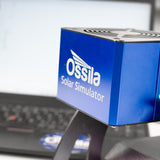Measuring Solar Cells with a Source Measure Unit

A source measure unit (SMU) is a vital piece of equipment used for many applications. In particular source measure units instrumental for characterizing solar cells. In combination with a solar simulator, you can use source measure units to take I-V curves, allowing you to measure solar cell efficiency.
Do You Need A Source Measure Unit To Measure Solar Cells?
For new solar cell architectures and designs, you have to measure the voltage across the solar cell and the current produced per unit area. You can do this using a simple multimeter for individual solar cell measurements. Simply measure the voltage generated by placing a multimeter across the terminals while the cell is illuminated and measure the current using a multimeter. Divide current by the area of the solar cell, to calculate the current density. Once you have voltage and current, you can calculate power using the following equation.
If you measure current density and voltage individually, this only tells you how much power per unit area a perfect solar cell device generates. This is because a good voltmeter has a very high internal resistance, and a good ammeter has near zero internal resistance:
- When measuring voltage by itself, no current can flow and hence no power is generated.
- When measuring the current across the terminals, the device is being tested when it has been short-circuited.
For real solar cells, the voltage output will depend on how much current is produced. With a source measure unit, you can measure current produced at many different voltages and measure an I-V curve. This gives you a more accurate characterization of key solar cell metrics.
Use a Source Measure unitJ-V Curve
A J-V curve, also referred to as an I-V curve allows you to calculate the amount of power that a solar cell generates. Below is a typical JV curve for a working solar cell. Understanding how to interpret J-V curves is incredibly useful when troubleshooting problems with your solar cell.
If you multiply the voltage by the current density, you get the power density produced by the solar cell. The peak of the graph below is the point at which maximum power is generated. This can tell you the maximum power you can gain from your solar cell, and the voltage that you need to acheive this maximum power.
Measuring a single J-V curves requires hundreds of data points, which is nearly impossible to do with a multimeter. Taking J-V curves is made easy with the Ossila Source Measure Unit. And in combination with our push-fit electrical test boards, you can quickly and accurately photovoltaic devices in a range of standard sizes. Along with the Ossila Solar Simulator, we have created a solar cell testing kit containing everything you need to test your solar cell devices.
Learn More
 Solar Cell J-V Curve: How to Measure the IV Curve of a Solar Cell
Solar Cell J-V Curve: How to Measure the IV Curve of a Solar Cell
When it comes to testing the performance of solar cells, accurate measurements and reliable equipment are essential. The fundamental way to test your solar cell performance is by taking a current-voltage (I-V or J-V) measurement. The I-V curve provides valuable insights into a solar cell's efficiency, power output, and more generally electrical characteristics within the device.
Read more... Interpreting J-V Curves: Insights into Solar Cell Performance
Interpreting J-V Curves: Insights into Solar Cell Performance
If you work in any solar cell research, you know that achieving optimal device performance can be challenging. There are many factors which can hinder your device performance including: device shunting or shorting, charge build-up at device interlayers, mismatch of energy levels leading to poor extraction, trap state formation and hysteresis.
Read more...